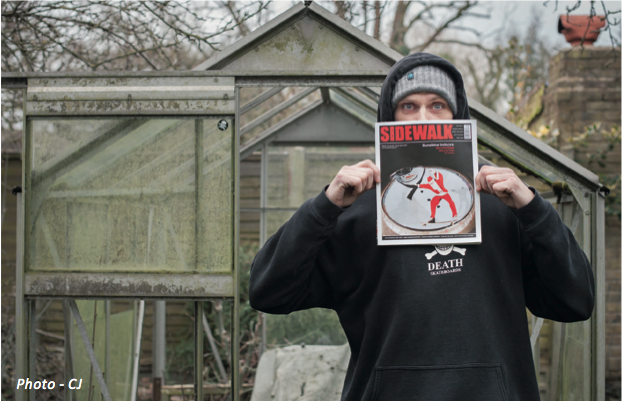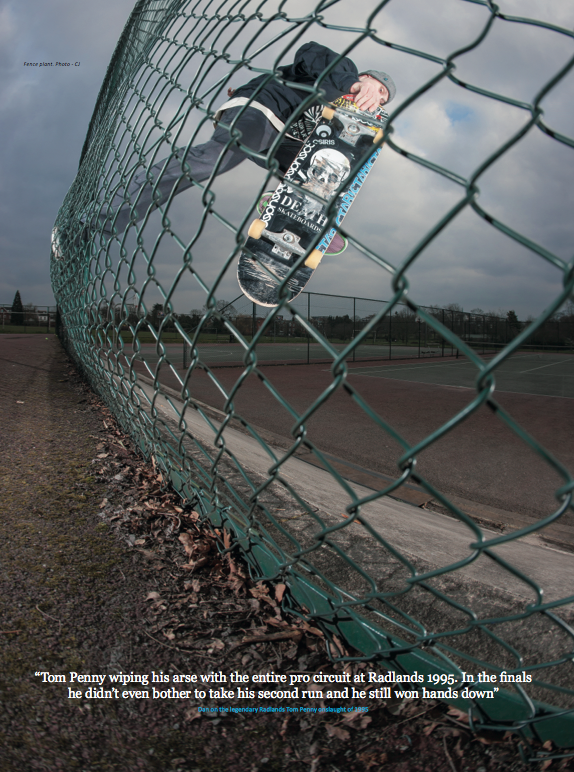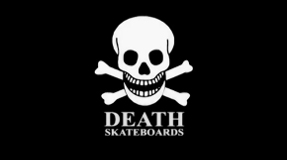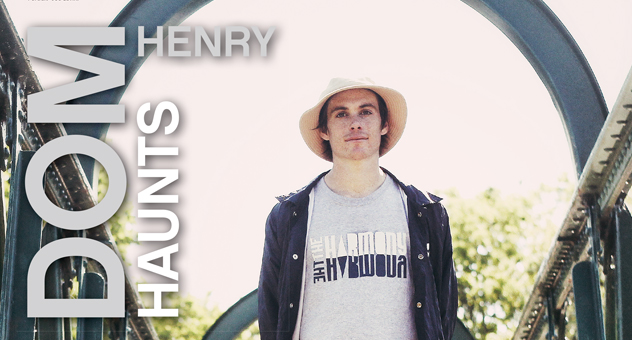From Sidewalk 200 – May 2013

Dan Cates
Sidewalk issue 135 : December 2007
Cover photo : David ‘Styley’ Steel
What do you remember about the process of shooting this cover?
You and Styley obviously put a lot of work in to make it happen – run us through it please.
– I remember it was actually Styley who came up with the idea one night whilst we were sat on a bus going through south London. Out of the blue he explained to me that he had noticed that the pool at Harrow was basically snowman-shaped and that we should paint it for a Christmas themed shot. I told him yes there and then, but didn’t hear anything more from him about it after that. It got to October and I finally phoned him up and told him that we were going to do it that week. The next day we got about 15 litres of masonry paint and got to work painting the pool from 11p.m. until about 2a.m. We went back the following night with a Santa Claus suit and for some reason a 42-inch long board. Strangely we made it onto the cover of the Christmas mag. I’m still stoked about it now! Thanks boys.
So 2007 – what was going on in your life at that point?
– Absolutely loads of skateboarding! Boots, Horsey and Steak were my main skate partners at the time, we were filming for ‘Better Than Life’ with Phraeza Hamilton, Toby Batchelor and our mate Mad Monk from Harlow. I was mainly shooting photos with Styley and Sam Ashley. Some epic skate trips went down around that time as well; Beirut with Horsey, Kuwait with Nicolson, and the high light of that year; Israel! We also did the Big Push with a young Ben Raemers as our very special guest. I was also in a skate rock band with Steak and Nicolson called ‘Day Release’. Good times!
You’re somebody who has skateboarding deeply ingrained in your soul so what did getting the cover of a skateboard mag mean to you then and what does it mean to you now, looking back on it?
– That was quite a big year for me; I started off, (to my amazement) by getting the January cover of Document and then ended the year, once again to my surprise, with the December cover of Sidewalk. For me personally it was pretty much a childhood dream come true. I had been accepted by the world of skateboarding and had featured on the cover of both mags in the same year. I couldn’t believe it. It was a good feeling then and it’s still a good feeling now, because there’s literally dozens of skaters that could have been on the cover instead of me.
What was the first photo you ever had in a skate magazine and what’s been your favourite photo of yourself that been run (anywhere) over the years?
– My first ever magazine photo was a pixelated video grab
of a feeble to fakie that ran across a double page spread in R.A.D as the background of an article about the 1993 Saint Albans mini ramp contest. I think it was taken from Alvin Singfield’s video camera.
Off the top of my head I would probably have to say that my favourite Sidewalk photo that I’ve had is my K-grind at Buckingham palace fountains from 1997. It’s a Wig photo. It had to be a Wig photo really didn’t it? My generation of skaters has a lot to thank him for.
What would be your Sidewalk favourite cover from over the years and why?
– I like all 3 of Boulala’s covers, especially the Melly in that pipe in Bristol, and I’ve always loved Shiers’s ice block shot, that just looked like so much fun to me. Dave Allen’s rock to fakie on that cut up full pipe was pretty awesome, but I would have to go with Howard Cooke’s frontside grind at Edge Lane. It’s got everything that you could want: the most insane spot, the gnarliest skater, good light and shot by a legendary photographer. What else is there?
Sidewalk has been going since 1995 so obviously skateboarding as a culture has changed massively over that time – if I were to ask you to point out the 5 most important/culturally significant events or developments that have occurred over that time, what would you pick and why?
1. Home grown Companies: They have probably changed the face of skateboarding culture more than anything else – at least across Europe anyway. The arrival of the home grown company around 1995 completely changed skater’s views, perceptions, ambitions, the market, the industry, sponsorship, the mags, the products, the graphics, everything. The only problem we have now is that unfortunately there are too many of them for the market to sustain.
2. The Internet: It not only made obvious differences in skateboarding, it changed the whole world and is still doing so.
3. The 900: When Tony Hawk made his first 900 at the 1999 X-Games in San Francisco, things changed almost over night. The world of skateboarding finally had an ambassador that could talk business with the big wigs in the main stream and through his video game and various other projects a lot of new kids were introduced to skateboarding the world over and for a few years a lot of skateboards got sold. Thank you Tony Hawk.
4. Dogtown and the Z-Boys: Around 2001 Stacy Peralta released a very good film about the birth of modern skateboarding called ‘Dogtown and the Z-Boys’ and as a result, men in their early 40’s who hadn’t skated in 20 years came out of the wood work in their thousands. Re-issues, old school shapes and the eBay market went nuts and a new group of skaters that had never existed before was born, paving the way for older pro’s and generally making skateboarding a far more diverse place.
5. Skateparks: More places to skate = more skaters and more skating = (in theory) a stronger industry and more money floating around to do rad stuff.

You’re one of the most well-travelled skateboarders on the planet and you’re still out exploring now after years and years of living frugally in order to fund this addiction: how many different continents have you been to?
– I have been to every continent except Antarctica, (I’m working on that one), and in my experience the most eye-opening places are in the ex-Soviet Union and parts of South and Central America. Kazakhstan, Ecuador, Cuba, Ukraine, and southern Siberia have been the best so far. I’m looking forward to North Korea.
What’s the worst situation that your travels have ever got you into?
– The German police chasing us through the streets of Munster with batons drawn in 1994 wasn’t the greatest experience. Having to chase off a group of gnarly taxi drivers in Mongolia in order to save Michael Makrodt from being beaten to death was a sketchy one also.
Why does traditional skate culture still matter at a point in history where Social Media and the Internet can grant everyone their 15 minutes of fame with minimal effort?
– The Internet is really effective for hosting moving images and offers a good platform for ‘The (disposable) Skate Edit’, something that didn’t have a home before YouTube. Things like that are in many cases a form of self publishing and anyone can do it. As far as still images are concerned, I believe that their primary place should be in print. Getting a rad skate shot in the mag is like releasing a single into the charts, as opposed to putting a rad skate shot on your Facebook, which is the equivalent of making a mix tape in your bed room.
You’ve always taken a different approach to the mainstream of ‘sponsored skateboarding’ – why is this?
– There are two reasons for my “unorthodox” approach to skateboarding:
1. Doing what everyone else is doing is not cool and it never will be.
2. I’m not a naturally talented skateboarder and though I do have lots of heart, I don’t have that much ability.
So at this point in your life, where you’ve had numerous pro boards, video parts, magazine coverage and are basically still ‘living the dream’: did it live up to your expectations?
– As far as the money, the sports cars, and the bitches are concerned, it couldn’t have been much more disappointing. Most of the other stuff was pretty good though and I really enjoyed it.
What does skateboarding mean to you at this point in your life Dan?
– For 23 years of my life skateboarding was the only thing that I did,
the only thing I thought about and the only thing that really mattered. Now that I go to school I have something else that is really important to me and my time is split between the two, (plus a little time for my girlfriend). I like it that way now, and as an older skater I feel very glad that I never stopped skating and that I’m lucky enough to be an art student in London still working in the skate industry and doing the things that I love. I have never lost the fire luckily and skateboarding means today what it meant at 11 years old: it’s the best thing in the world.
Are you able to imagine a life without skateboarding?
– That is a really retarded thing to imagine.
As somebody who has been heavily involved in running a well-respected UK company with global riders and a back catalogue of quality output, what’s your perspective on the current state of the UK skateboard scene and industry?
– The scene is fragmented, but there are lots of young faces coming through which is encouraging. My only gripe is that we desperately need more exciting characters to materialise and there still aren’t many of us in the 30+-age bracket, which gets a bit depressing sometimes. As for the industry, I would say that there are too many small companies competing for market share and to top things off, everyone is broke.
What about skateboarding globally?
– Probably the same.
Are there any particular skateboarders that you feel have contributed more than others to this sprawling multi-million dollar culture?
Stacy Peralta: Inventor of the modern skate video.
Jamie Thomas: Pioneer of gnarly street skating, gnarly skate industry business strategy and the ‘death lens’.
Danny Way: The first super pro, inventor of the ‘Mega ramp’, pushed the sport to new levels over and over again.
Eric Koston: The greatest of all time.
Tony Hawk: Brought skateboarding to the masses.
Rob Dyrdek: Made it possible for pro skaters to start making a more realistic amount of prize money through Street League. Still nowhere near as much as golf, but it’s a damn good start.
The list goes on…
What’s the pinnacle moment of UK skateboarding in your opinion and why?
– That is a ridiculous question, but I will answer it anyway: Tom Penny wiping his arse with the entire pro circuit at Radlands 1995. In the finals he didn’t even bother to take his second run and he still won hands down. It was amazing. He made us all so proud; it felt like the UK had told the Americans to go f*ck themselves in the most glorious way. Tom was the best skateboarder in that skatepark and the Americans just had to except it.
How do you see skateboarding evolving from this point? Have we exhausted the possibilities yet?
– It’s about to go wacky.
Give us the benefit of your wisdom Dan – why is skateboarding worth it?
– Because it’s the best thing ever…
Anything else that you want to add?
– Thank you Sidewalk, the last 18 years would have been a rocky road without you. Don’t let the bastards grind you down. Let’s catch up again in issue 300.

Fence plant. Photo – CJ







